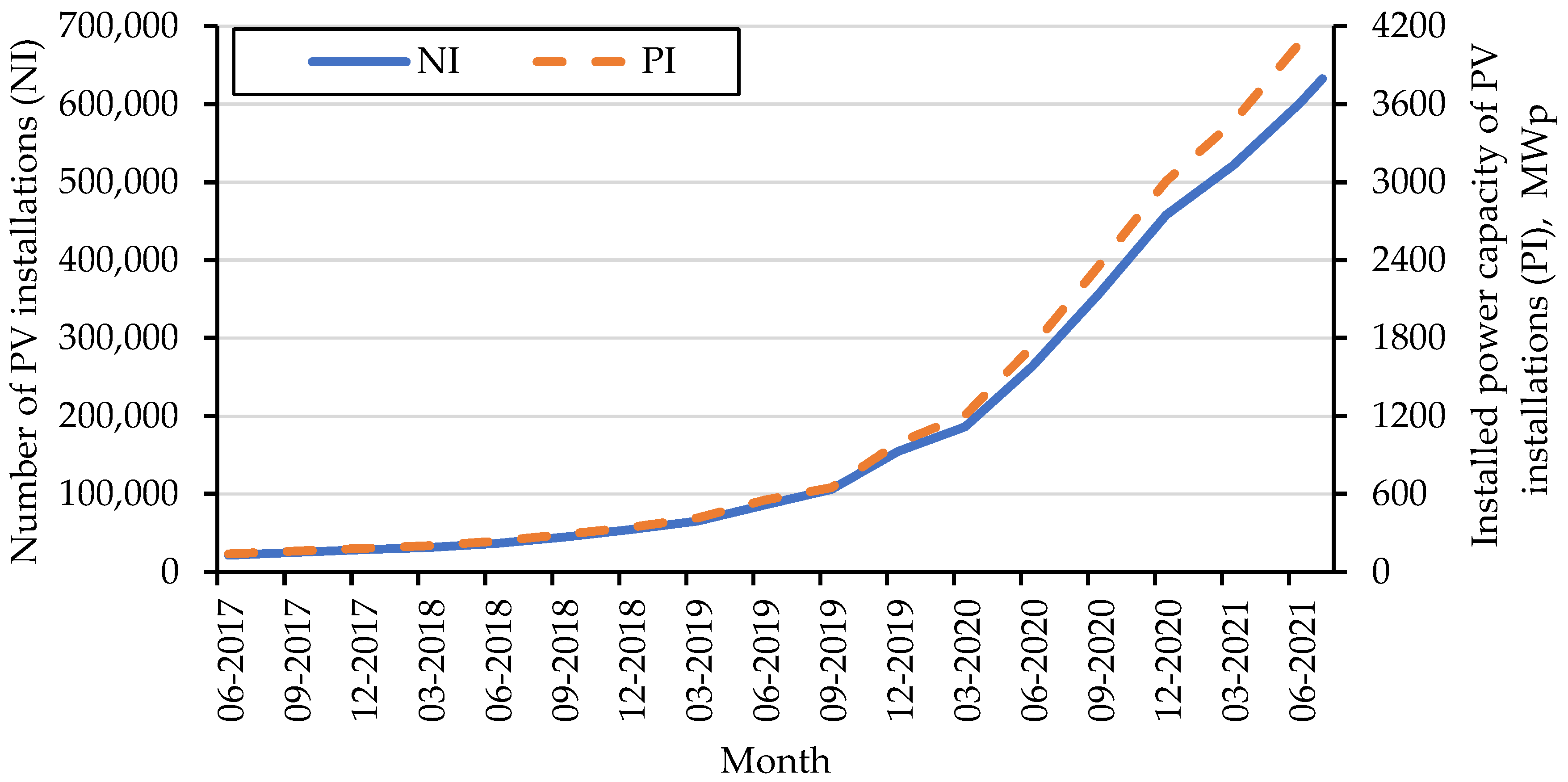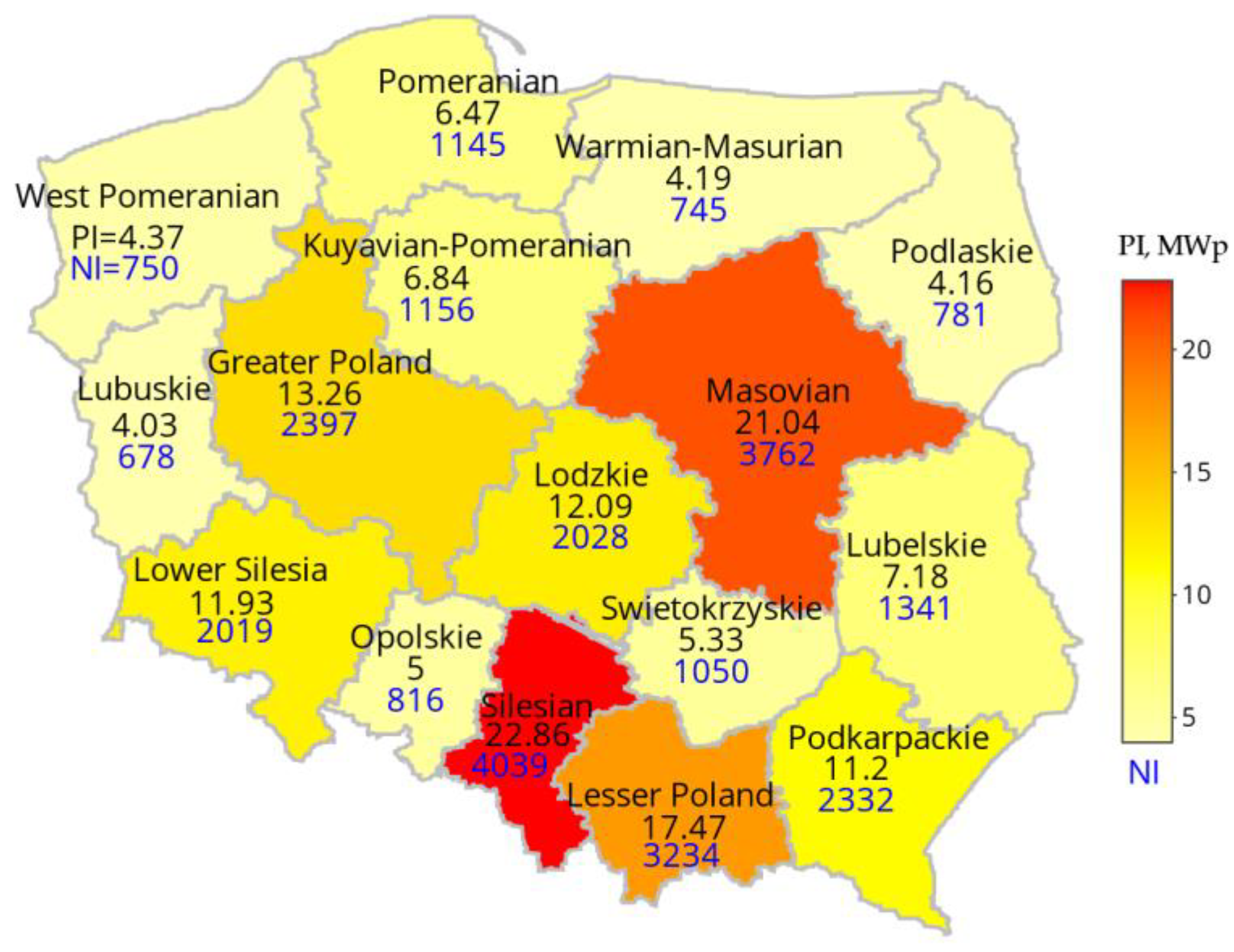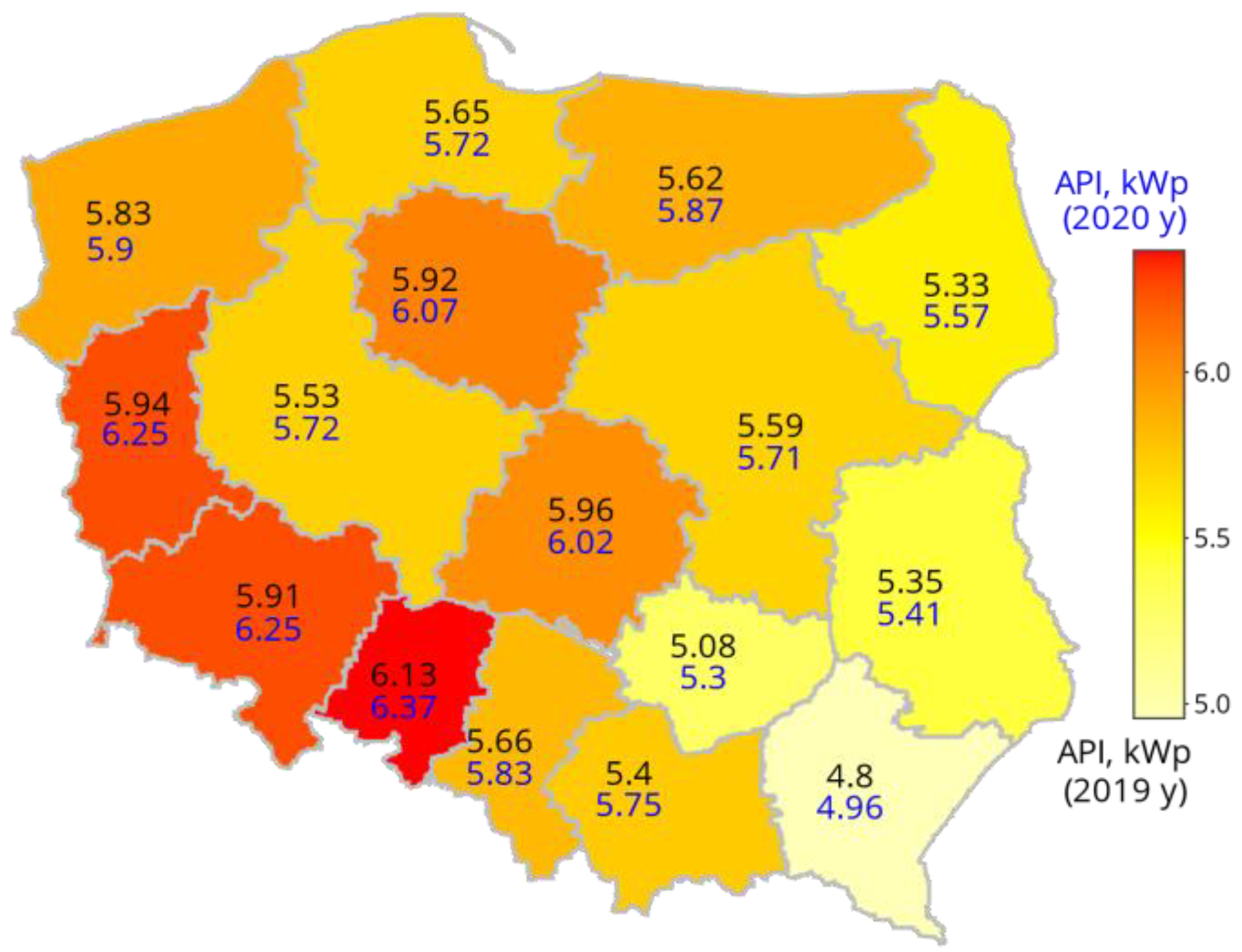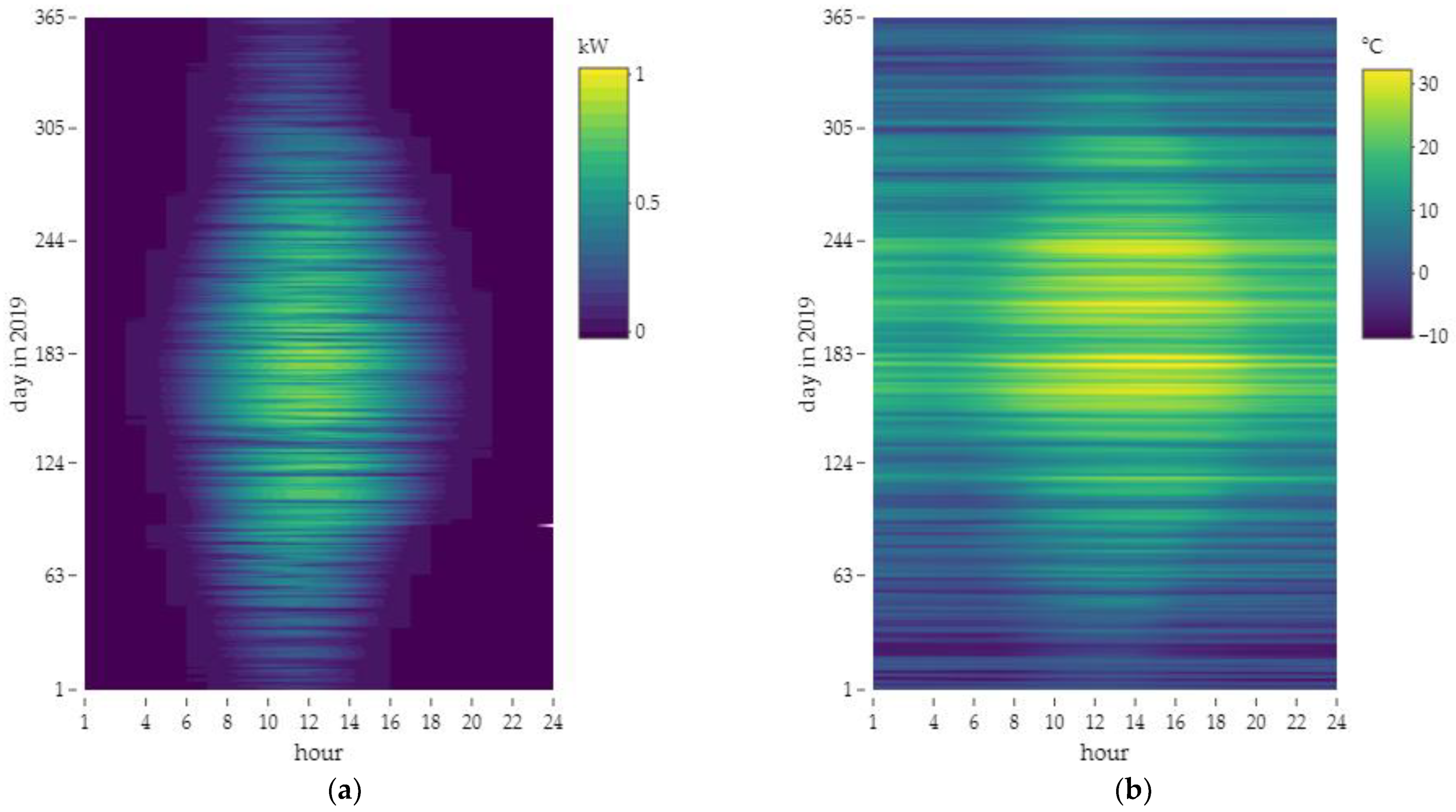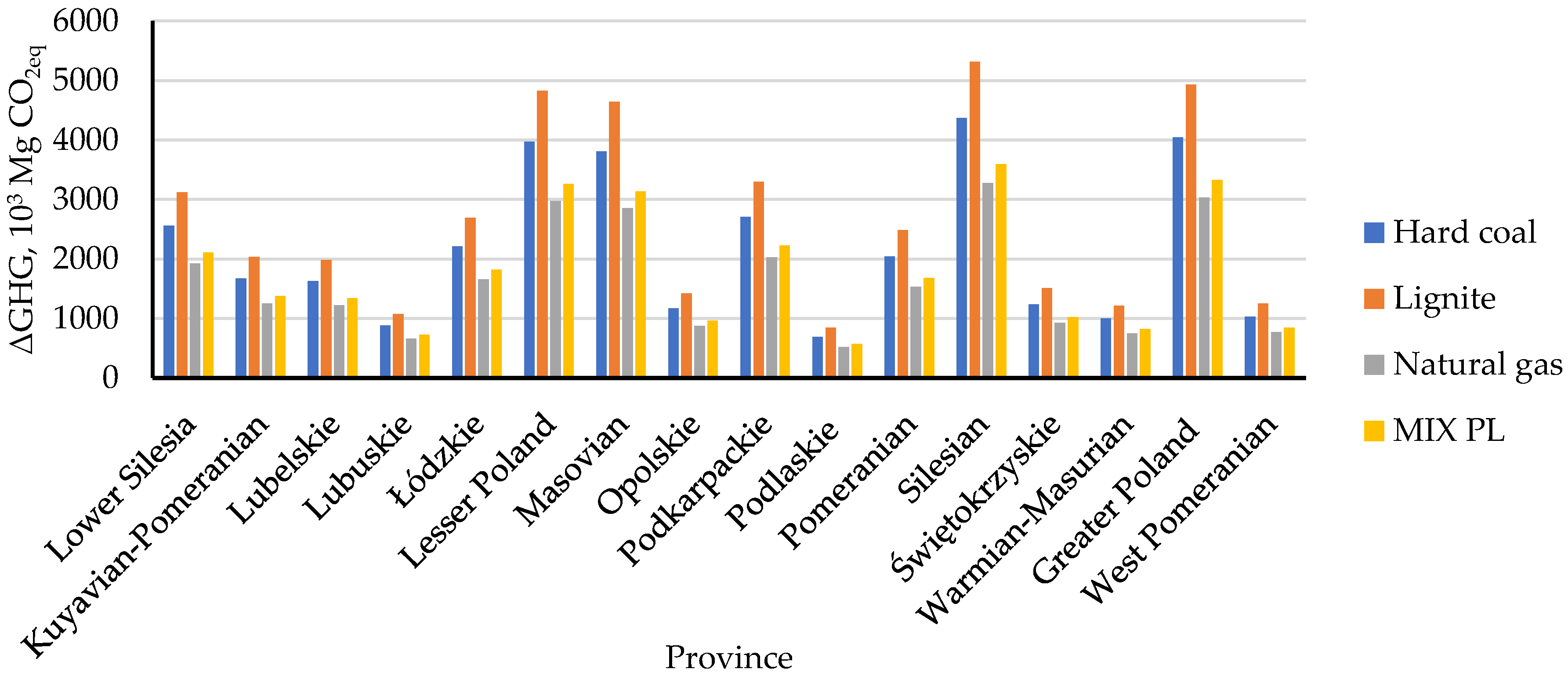1. Introduction
Consequent to population growth and economic development, the demand for energy is constantly growing—the International Energy Agency predicts that the demand for electricity will increase by 30% in 2040, compared with the base year 2016 [
1,
2]. Unfortunately, attempts to create better living conditions for society involve serious problems related to fossil fuel combustion and its negative environmental impact: climate changes, acid rains, eutrophication, emissions of greenhouse gases (GHG), mercury and other pollutants, etc. [
3,
4]. Thus, there is also growing public awareness of the urgent need to solve these most pressing environmental problems related to energy production. The consequences of these changes caused the 2015 Paris agreement to limit global warming to well below 2 °C, compared with the pre-industrial era, in order to reduce the risk and damage caused by climate changes [
5]. Considering this, the shift from fossil fuels to renewable energy sources seems to be a good and future-proof solution. At the same time, public policy has largely favoured wind and solar technologies for energy production among other technologies using renewable sources (RESs), which contributed to the growth of installations powered by these sources [
6,
7,
8]. More importantly, many premises indicate that such a climate policy will determine future directions for actions [
9,
10,
11], where solar energy technologies will have leading importance [
12,
13]. On the example of the European Union itself, it can be seen how the electricity generation capacity has changed from 1.9 GW to over 133 GW in 2010–2019. The year 2019 alone brought 16.5 GW of new installed capacity in the EU [
14]. As a result, the power installed in photovoltaics both in the EU and United Kingdom could generate 5.2% of the final electricity demand (about 150 TWh) at the end of 2019 [
15]. The efficiency of photovoltaic systems depends on several factors, including photovoltaic technology and its structure and components used, partial shading, losses related to soiling of the panels, as well as individual environmental factors for different latitudes such as the insolation, temperature, angular losses, etc. [
16,
17,
18]. Poland, as one of the EU Member States, faces an urgent need to develop new solutions for the energy sector that would be appropriate in terms of environment, technology, and economy [
19,
20]. This is even more important in the context of the fact that the Polish energy mix is largely based on the use of fossil fuels (mainly coal) as an energy source—in 2020, in Poland, 70.18 TWh was generated from hard coal, while 34.42 TWh was generated from lignite, with total energy generation at the level of 140.56 TWh, which was 49.93% and 34.42%, respectively [
21,
22]. Data shows that in 2018 in Poland, greenhouse gas emissions were 415.9 million tons of carbon dioxide equivalents (CO
2eq) [
23]. The high and constantly growing prices of CO
2 emission rights make coal power plants less and less profitable in operation [
24,
25]. The prices of CO
2 emissions over the last few years are presented in
Figure 1.
Analysing the current situation on the photovoltaic market in European countries with a temperate climate, Poland, immediately after Germany and The Netherlands, has the largest PV market [
27]. With an estimated annual insolation value of 1000 kWh/m
2 [
28,
29], the Polish photovoltaic sector is the fastest-developed renewable energy sector—with a total capacity of micro-installations of 4075.5 MW (data as of 31 June 2021). Comparing this with the total installed capacity as of 30 June 2017, it indicates almost a 25-fold increase in less than 4 years (
Figure 2) [
30]. As a result, Poland ranks fifth in terms of creating new PV installation capacities, closely behind Germany, Spain, The Netherlands, and France. Forecasts show that PV installations will continue to be popular in the future, and installed capacity may, with conservative estimates, increase by around 5–7 GWp by 2030 [
31] and by around 10–16 GWp by 2040 [
32,
33].
The development of photovoltaics both in Poland and the entire EU was possible to a large extent through programs aimed at encouraging investors to invest in solar technologies [
6,
7]. At the same time, designing a renewable energy policy through various types of support programs, tax breaks, subsidies, is extremely important from the point of view of efficiency, environmental friendliness, as well as social equity [
34]. The price effect pushes producers with high marginal costs from the market (which may be influenced by the high costs of carbon certificates in the case of conventional power plants) and a decrease in the wholesale energy price. On the other hand, consumers bear to a large extent hidden costs related to the development of RES since these subsidies are refinanced from taxes. As a result, the allocation of aid funds in RES is extremely important, and it is worth examining whether the mechanisms governing it are not defective, and there are no problems with the appropriate allocation of funds [
7,
35]. Olczak et al. [
36] analysed the allocation of funds for photovoltaic micro-installations in Poland in terms of inequality between voivodeships in terms of their use. In the context of switching from conventional fossil technologies to generation using renewable sources, much is said about reducing GHG emissions during their operation [
37]. However, when comparing the difference in GHG emissions between systems using fossil fuels and renewable sources, their operation time should be considered, as well as the entire life cycle, by conducting an appropriate life cycle analysis (LCA) for each of the compared systems [
38]. Life cycle assessment (LCA) is a well-known method used to assess the environmental impact of a product or process throughout its entire life cycle (from its manufacture, through operation, to disposal) [
39], and consists of four main parts: goal and scope definition, inventory analysis, impact assessment and interpretation [
40].
There are numerous studies on PV LCAs in the literature [
41,
42,
43,
44,
45]. Bracquene et al. [
41] discussed how the eco-design of PV can contribute to reducing the environmental impact of photovoltaic panels. Müller et al. [
42] conducted an LCA analysis of photovoltaic (PV) systems from sc-Si glass–backsheet and glass–glass modules produced in China, Germany, and the European Union (EU), considering current inventory data. Celik et al. [
43] analysed two different structures of perovskite photovoltaic cells using the LCA with cradle-to-grave approach. Bogacka et al. [
44] conducted a scenario analysis based on the LCA of the environmental impact of PV recycling. Ansanelli et al. [
45] carried out an LCA to assess the environmental performance of a new process for recycling crystalline silicon (c-Si) solar panels at the end of life and to improve the circular economy of recovered materials.
Despite such extensive research linking LCA with PV, in the context of subsidy programs, it seems important to check whether the replacement of fossil fuels by PV will help to avoid emissions (if so, to what extent) in the next 30 years. The novelty of this study is the estimation of the effectiveness of a subsidy program for PV installations, taking into account the LCA analysis—the conclusions obtained as a result of this study may influence the actions of decision makers and support the design of such programs. The authors infer a significant gap as regards checking how the replacement of dirty energy sources by PV in an energy mix such as Poland will affect this transition and avoid emissions.
The paper is structured as follows:
Section 2 focuses on presenting the characteristics of the results of the subsidiary program “My Electricity”, whose purpose was to partially refinance PV micro-installation in households in Poland. Data as of 14 July 2021 includes over 90% of installations covered by the program as part of the two editions which were carried out in 2019–2020. In
Section 3, research methodology is presented, including equations for PV electricity production, the subsidy amount for produced energy, and avoided CO
2eq emission. In
Section 4, an analysis of the subsidy program is conducted to evaluate the “My Electricity” program as one of the methods of reducing CO
2eq emissions in Poland. This was achieved by determining the electricity produced in the first year and over 30 years and the cost of co-financing PV installations for electricity production per 1 MWh. LCA model calculations according to the IPCC GWP 100a method were used to estimate emissions for monocrystalline and polycrystalline PV systems. The unit GWP indicators obtained for hard coal, lignite, natural gas, and the Polish energy mix were used to determine the avoided emissions. Finally,
Section 5 concludes the environmental impact of implementing the “My Electricity” program to avoid emissions in Poland over a 30-year perspective.
2. The Results Characteristics of the “My Electricity” Program
The My Electricity program was implemented in the years 2019–2020. The aim of the program was to increase the number of prosumers of PV micro-installations among households in Poland by over 200 thousand. The initial budget of the program was PLN 1 billion (Polish zlotys) at the end of 2020, and the budget was extended to approx. EUR 250 million (EUR 1 = PLN 4.5). According to the data as of 14 July 2021, the amount of funds spent was EUR 251 million; this value covers over 90% of the installations created under the program.
The main convenience for the beneficiaries was a non-returnable subsidy covering 50% of eligible costs up to a maximum of EUR 1111 per installation from the 2–10 kWp range. The eligible costs include the purchase of a new installation and its assembly. The installation is subject to control up to 3 years after the grant is awarded.
In the first round of the program, 28,457 installations were created (with a capacity of 158.4 MWp), i.e., approx. 15% of the total planned pool of installations for 2 years. The average power of the installation was 5.57 kWp, the median was 5.1 kWp, and the average subsidy amount was EUR 1102 (198 EUR/kWp). Detailed results by provinces are presented in
Figure 3.
Most installations were built in the Silesian (4039), Masovian (3762), and Lesser Poland (3234) provinces with a total capacity of 61.4 MWp, the least in the Lubuskie (678), Warmian-Masurian (745), West Pomeranian (750) provinces, with a total capacity of 12.6 MWp. Less than 1000 installations were also built in the Podlaskie (781) and Opolskie (816) provinces. The average subsidy amount was PLN 4958 (EUR 890/kWp). The contrast in the number of installations is surprising—voivodeships with the highest number of installations are adjacent to the areas with the lowest number of installations.
As of 14 July 2021, 197.997 installations with a total capacity of 1137 MWp were built in the second round of the program [
46]. This is about 8 times more installations than the first round. The average power of the installation is 5.73 kWp (+3% compared with round no. 1 [
36]), and the median is 5.25 kWp. The average subsidy amount was EUR 1110 (193 EUR/kWp). Detailed results for individual voivodeships are presented in
Figure 4.
Most installations were built in the Greater Poland Province (24,260) with a total capacity of 138.7 MWp. Similar values were achieved in the following voivodships: Silesian (23,121) Lesser Poland (21,747) and Masovian (21,482). The fewest installations were built in Podlaskie Province (4043), with a total capacity of 22.5 MWp.
In both rounds of the program, 226,454 installations with a total capacity of 1295 GWp were built. The average power of the installation is 5.72 kWp, and the median power is 5.22 kWp. The average grant amount is EUR 1109 (194 EUR/kWp). Detailed summary results for individual voivodships are presented in
Figure 5.
In total, in both rounds, most installations were built in the following provinces: Silesian (27,160), Greater Poland (26,657), Masovian (25,244), and Lesser Poland (24,981), with a total capacity of 596 MWp. In the years 2019–2020, the least interest in co-financing photovoltaic installations under the “My Electricity” program was in the Podlaskie Province (4824). The total installed capacity in micro-installations in Podlaskie Province was 26.7 MWp. The differences in power in individual provinces result, from population, urbanisation, insolation of regions [
47,
48].
It can also be observed that in each province the average installation capacity increased (
Figure 6), despite the fact that the subsidy system is the most financially effective at installation capacity close to 2 kWp [
48].
According to the weighted power of PV installations created under the “My Electricity” program, determined on the basis of the total power of the installations and geographical coordinates, the centre of Poland was determined to be in the Łódzkie Province—for the place of Łask near Łódź with coordinates 51.61° N and 19.18° E.
5. Conclusions
In the years 2019–2020, the Polish government offered prosumers a program of co-financing PV installations called “My Electricity”. The amount of the subsidy was up to max. 50% of eligible costs, up to a maximum amount of PLN 5000 (EUR 1111). In the assumed period, more than half of the photovoltaic micro-installations established in Poland received funding under the “My Electricity” program. The total cost of the subsidy program was EUR 251 million. Currently, the program continues as part of the third round from July 2021 with changed conditions, including a reduced maximum grant amount of EUR 667 for installations.
The average power of PV micro-installations with co-financing is 5.72 kWp. Most installations were built in the very industrialised Silesian Province (27,160), the lowest in the Podlaskie Province (4824). In total, installations with a total capacity of 1295 MWp were created under the “My Electricity” program. With the productivity of PV installations at the level of 1025–1104 kWh/kWp/year (differentiated by region), these installations will contribute to the production of approx. 38 TWh of green energy over 30 years.
It is broadly recognised that PV systems can be treated as a source of green energy. The environmental effects of the “My Electricity” program implementation in Poland, measured by the avoided CO2eq emissions based on the IPCC GWP 100a indicator, are highly positive in light of the fact that the Polish power industry is still largely based on fossil fuels. The detailed LCA analysis of the installations allowed for the determination of CO2eq emissions at the average level of 9390.7 kg per system, while the average CO2eq emission per functional unit was 0.056 kg CO2eq/kWh, which corresponds to the Central European conditions of insolation. The particular indicators are influenced by the type of technology and location of the system, as stated in this study. Future analysis should consider the relationship between the size of the system and the CO2eq emissions to show the areas with the greatest effectiveness of support.
According to the analysis, while reducing the carbon footprint of energy units by 92–95%, PV systems built in the “My Electricity” program can contribute to the avoidance of 26–42·106 Mg of greenhouse gas emission in 30 years of life cycle perspective. This, together with the analysed economic aspects, leads to the conclusion that the use of this type of financial instrument is fully justified, in particular in the case of stimulating the development of energy markets with a large share of conventional energy sources.

